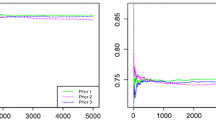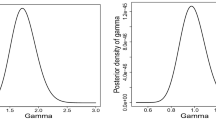Abstract
The statistical inference of multicomponent stress-strength reliability under the adaptive Type-II hybrid progressive censored samples for the Weibull distribution is considered. It is assumed that both stress and strength are two Weibull independent random variables. We study the problem in three cases. First assuming that the stress and strength have the same shape parameter and different scale parameters, the maximum likelihood estimation (MLE), approximate maximum likelihood estimation (AMLE) and two Bayes approximations, due to the lack of explicit forms, are derived. Also, the asymptotic confidence intervals, two bootstrap confidence intervals and highest posterior density (HPD) credible intervals are obtained. In the second case, when the shape parameter is known, MLE, exact Bayes estimation, uniformly minimum variance unbiased estimator (UMVUE) and different confidence intervals (asymptotic and HPD) are studied. Finally, assuming that the stress and strength have the different shape and scale parameters, ML, AML and Bayesian estimations on multicomponent reliability have been considered. The performances of different methods are compared using the Monte Carlo simulations and for illustrative aims, one data set is investigated.






Similar content being viewed by others
References
Antweiler RC (2015) Evaluation of statistical treatments of left-censored environmental data using coincident uncensored data sets. II. group comparisons. Environ Sci Technol 49:13439–13446
AL Sobhi MM, Soliman AA (2016) Estimation for the exponentiated Weibull model with adaptive Type-II progressive censored schemes. Appl Math Model 40:1180–1192
Balakrishnan N, Aggarwala R (2000) Progressive censoring: theory, methods and applications. Birkhäuser, Boston
Bhattacharyya GK, Johnson RA (1974) Estimation of reliability in multicomponent stress-strength model. J Am Stat Assoc 69:966–970
Chen MH, Shao QM (1999) Monte Carlo estimation of Bayesian Credible and HPD intervals. J Comput Gr Stat 8:69–92
Efron B (1982) The jackknife, the bootstrap and other re-sampling plans. SIAM, CBMSNSF regional conference series in applied mathematics, No. 34, Philadelphia
Epstein B (1954) Truncated life tests in the exponential case. Ann Math Stat 25:555–564
Gradshteyn IS, Ryzhik IM (1994) Table of integrals, series, and products, 5th edn. Academic Press, Boston
Hall P (1988) Theoretical comparison of bootstrap confidence intervals. Ann Stat 16:927–953
Hanagal DD (1999) Estimation of system reliability. Stat Pap 40:99–106
Kizilaslan F, Nadar M (2018) Estimation of reliability in a multicomponent stress-strength model based on a bivariate Kumaraswamy distribution. Stat Pap 59:307–340
Kizilaslan F, Nadar M (2016) Estimation and prediction of the Kumaraswamy distribution based on record values and inter-record times. J Stat Comput Simul 86:2471–2493
Kohansal A (2017) On estimation of reliability in a multicomponent stress-strength model for a Kumaraswamy distribution based on progressively censored sample. Stat Pap. https://doi.org/10.1007/s00362-017-0916-6
Kundu D, Joarder A (2006) Analysis of type-II progressively hybrid censored data. Comput Stat Data Anal 50:2509–2528
Lindley DV (1980) Approximate Bayesian methods. Trab de Estad investig oper 3:281–288
Nadar M, Kizilaslan F (2016) Estimation of reliability in a multicomponent stress-strength model based on a Marshall-Olkin bivariate weibull Distribution. IEEE Trans Reliab 65:370–380
Nadar M, Papadopoulos A, Kizilaslan F (2013) Statistical analysis for Kumaraswamy’s distribution based on record data. Stat Pap 54:355–369
Nassar M, Abo-Kasem OE (2017) Estimation of the inverse Weibull parameters under adaptive type-II progressive hybrid censoring scheme. J Comput Appl Math 315:228–239
Ng HKT, Kundu D, Chan PS (2009) Statistical analysis of exponential lifetimes under an adaptive Type-II progressively censoring scheme. Nav Res Log 56:687–698
Sürücü B (2015) Testing for censored bivariate distributions with applications to environmental data. Environ Ecol Stat 22:637–649
Tate EL, Freeman SN (2000) Three modelling approaches for seasonal streamflow droughts in southern Africa: the use of censored data. Hydrol Sci J 45:27–42
Author information
Authors and Affiliations
Corresponding author
Additional information
Publisher's Note
Springer Nature remains neutral with regard to jurisdictional claims in published maps and institutional affiliations.
Appendix A
Appendix A
For three parameters case, we compute 13 at \(\widehat{\Theta }=(\widehat{\theta }_1,\widehat{\theta }_2,\widehat{\theta }_3)\), where
In our case, for \((\theta _1,\theta _2,\theta _3)\equiv (\alpha ,\theta ,\lambda )\) and \(u\equiv u(\alpha ,\theta ,\lambda )=R_{s,k}\) as provided in (3), we have
Also, by using \(\ell _{ij}, i,j = 1,2,3, \sigma _{ij}, i,j = 1,2,3\) can be obtained and
and other \(\ell _{ijk}=0\). In addition, \(u_1=\partial R_{s,k}/\partial \alpha =0\), \(u_{i1}=\partial ^2 R_{s,k}/(\partial \theta _i\partial \alpha )=0\), \(i=1,2,3\), and \(u_2\), \(u_3\) are given in (10) and (11), respectively. Also,
Hence,
Rights and permissions
About this article
Cite this article
Kohansal, A., Shoaee, S. Bayesian and classical estimation of reliability in a multicomponent stress-strength model under adaptive hybrid progressive censored data. Stat Papers 62, 309–359 (2021). https://doi.org/10.1007/s00362-019-01094-y
Received:
Revised:
Published:
Issue Date:
DOI: https://doi.org/10.1007/s00362-019-01094-y
Keywords
- Adaptive Type-II hybrid progressive censored
- Approximation maximum likelihood estimation
- MCMC method
- Multicomponent stress-strength reliability
- Weibull distribution




